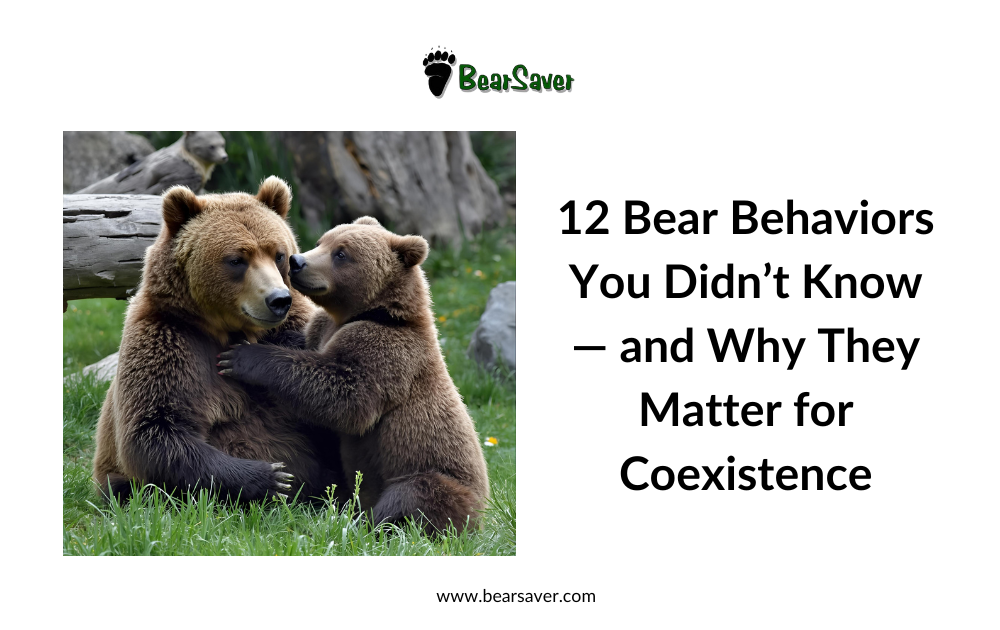12 Bear Behaviors You Didn’t Know — and Why They Matter for Coexistence
Posted by Securr Blogger on
Bears are among nature’s most intelligent, curious, and adaptable creatures. They play a vital role in maintaining healthy ecosystems, yet human-bear encounters continue to increase as communities expand into wild habitats. The more we understand bear behavior, the better we can design communities—and waste management systems—that prevent conflict and foster coexistence.
At BearSaver, the leading manufacturer of animal-proof commercial trash enclosures, we believe knowledge and responsible waste management go hand-in-hand in protecting both people and wildlife. Here are 12 fascinating bear behaviors that shed light on how we can live safely and respectfully alongside these remarkable animals.
1. Bears Have Exceptional Memories
Bears possess one of the best spatial memories in the animal kingdom. They remember food sources and return to them year after year. If a bear finds unsecured trash even once, it will likely revisit that location—making bear-resistant trash cans essential in preventing repeat visits.
2. They Can Smell Food from Miles Away
A bear’s sense of smell is roughly seven times stronger than a bloodhound’s. Even small food scraps or scented garbage can attract them from over 20 miles away. Properly sealed containers like BearSaver’s animal-proof waste bins eliminate odors that lure bears into human areas.
3. Bears Are Naturally Wary of Humans
Contrary to popular belief, most bears prefer to avoid people. When bears appear aggressive, it’s often out of fear or surprise. Reducing attractants—such as garbage, pet food, and birdseed—helps prevent unwanted encounters that could lead to unnecessary harm.
4. They Are Incredibly Intelligent Problem Solvers
Bears have been observed opening car doors, unlatching coolers, and even unscrewing jars. They’re quick learners, adapting behavior based on experience. This is why commercial-grade bear-proof containers are designed with complex, bear-resistant latches that remain easy for humans to use but impossible for bears to manipulate.
5. Bears Communicate Through Body Language and Sound
From huffs and jaw pops to standing on hind legs, bears use a range of signals to express curiosity or assert dominance. Understanding these cues helps outdoor workers, campers, and residents interpret bear behavior calmly and correctly.
6. They Are Omnivores with a Seasonal Diet
Bears eat a wide range of foods—berries, roots, insects, and occasionally meat. However, during hyperphagia (late summer to fall), they can consume up to 20,000 calories a day preparing for hibernation. That’s when trash cans, dumpsters, and food waste become prime targets—making secure waste systems more crucial than ever.
7. Bears Exhibit Individual Personalities
Just like humans, bears have unique temperaments. Some are shy; others are bold or curious. Recognizing this individuality reminds us that bears are not pests but sentient animals deserving of respect—and of environments designed to minimize conflict.
8. They Mark Territory to Avoid Conflict
Bears often claw or rub trees not only to mark territory but also to communicate with other bears. These natural behaviors reduce direct confrontation, a model humans can follow by clearly marking and securing human “territories” like campsites and neighborhoods with bear-resistant infrastructure.
9. Mother Bears Are Fiercely Protective
A sow will defend her cubs with unmatched courage. Most bear-related injuries occur when humans unknowingly approach cubs. Keeping trash and food away from residential or trail areas ensures that bears raising young aren’t drawn into danger zones.
10. Bears Are Primarily Nocturnal Near Humans
To avoid human activity, many bears have shifted to nighttime foraging in populated areas. This behavioral adaptation highlights their intelligence—and underscores why secure nighttime waste storage is vital for communities in bear country.
11. They Hibernate—but Not Completely Sleep
During hibernation, a bear’s body temperature drops and metabolism slows, but they can still wake easily if disturbed. Minimizing disturbances and food temptations around denning areas helps maintain their natural cycles and survival rates.
12. Bears Learn Behaviorally from Each Other
Cub bears learn feeding habits and foraging patterns directly from their mothers. If a mother bear learns that garbage is an easy food source, her cubs will inherit that same behavior. Stopping access to trash early prevents generations of problem bears.
Coexistence Through Responsibility
Each of these behaviors tells the same story: bears are intelligent survivors responding to human impact on their habitats. When humans secure food sources, properly dispose of waste, and respect wildlife boundaries, bears remain wild—and both species benefit.
That’s where BearSaver comes in. Our bear-proof commercial trash enclosures, recycling systems, and food waste containers are designed to eliminate attractants that draw wildlife into human environments. Whether for parks, resorts, or municipalities, BearSaver provides sustainable solutions for communities committed to coexistence.
Join the Movement for Safer, Cleaner, Bear-Smart Communities
Coexistence isn’t just possible—it’s practical. By choosing BearSaver, you’re investing in the safety of people, the preservation of wildlife, and the protection of our shared environment.
Contact BearSaver today:
📞 800.851.3887
📧 sales@bearsaver.com
🌐 www.bearsaver.com

